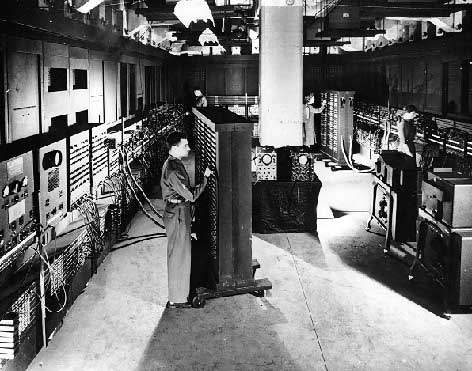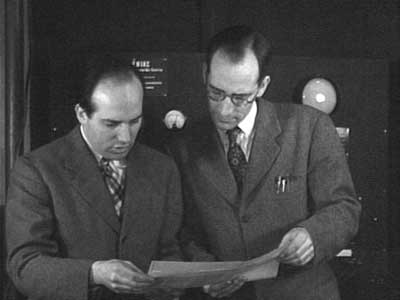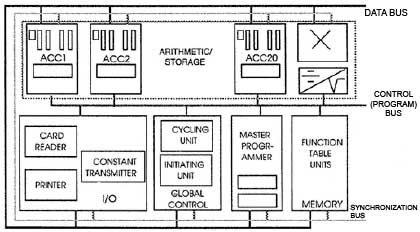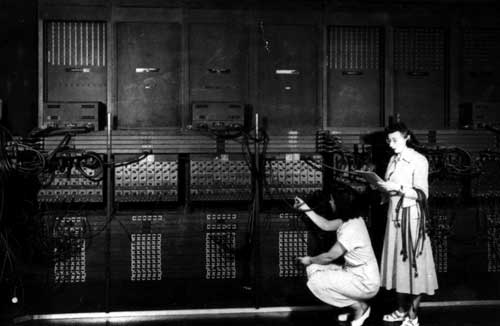
6 Facts about ENIAC Computer
- ENIAC, which meant “Electronic Numerical Integrator And Computer,” was built between 1943 and 1946.
- John Mauchly and J. Presper Eckert came up with the idea for ENIAC.
- ENIAC used nearly 17,500 vacuum tubes, 7,200 diodes, and miles of wire to construct the machine.
- ENIAC took up 1,800 square feet (170 m2), the equivalent of a vast room.
- ENIAC also included seventy thousand resistors, 10,000 capacitors, 1,500 relays, 6,000 manual switches, and 5 million soldered connections.
- There was only one ENIAC ever built.
The History of ENIAC Computer: What to know
ENIAC’s and its contemporaries’ origins may be traced back to World War II. Then, artillery units used tables to estimate the trajectory of the shells they were firing, still a mind-numbing effort to compute the variables—the gun’s angle, the terrain’s condition, and other variables.
The military commission for the new computer began on May 31, 1943, with John Mauchly and John Presper Eckert as partners, with Mauchly serving as principal consultant and Eckert as chief engineer. When Eckert and Mauchly met in 1943, he was a graduate student at the University of Pennsylvania’s Moore School of Electrical Engineering.
The ENIAC took around a year to design and 18 months to build, with half a million dollars in tax money. The machine wasn’t introduced officially until November 1945, when the war had ended. However, not all was lost. The military continued to use ENIAC for computations such as hydrogen bomb design, weather forecasting, cosmic-ray investigations, thermal ignition, random-number studies, and wind tunnel design.

Mauchly and Eckert invented the Electrical Numerical Integrator And Calculator in 1946. (ENIAC). The US military-funded this research because it needed a computer to calculate artillery-firing tables, which are the parameters for different weapons in different conditions to ensure target accuracy.
After hearing about Mauchly’s research at the Moore School, the Ballistics Research Laboratory (BRL), the military branch in charge of compiling the tables, became interested. Mauchly had already designed several calculating machines, and in 1942 he began work on a new one based on John Atanasoff, an inventor. The latter employed vacuum tubes to speed up calculations.
In 1947, ENIAC was granted a patent. “With the rise of everyday use of elaborate computations, speed has become vital to such a high extent that there is no machine on the market today capable of supplying the complete demand of modern computational methods,” according to an excerpt from the patent (US#3,120,606) filed on June 26.

Some of ENIAC’s rivals, such as the ABC and Z3, were slower and could only solve minor tasks. It’s even debatable whether the ABC, which solely did calculations for demonstrations, was completed.
ENIAC Versions: Each Edition
Version 1
After 1947, ENIAC received several upgrades, including a primitive read-only stored programming method that used the function tables as program ROM, with programming done by setting the switches. The Goldstines, on the one hand, and Richard Clippinger and his group, on the other, worked out numerous variations of the idea, which was incorporated in the ENIAC patent. Clippinger conferred with von Neumann about the best set of instructions to use. Von Neumann recommended a one-address architecture because it was easier to construct than Clippinger’s three-address architecture.
The program counter was three digits of one accumulator, the central accumulator was another accumulator, the address pointer for reading data from the function tables was the third accumulator, and the majority of the other accumulators (1–5, 7, 9–14, 17–19) were utilized for data memory.
The converter unit was installed in March 1948, allowing regular IBM cards to be programmed using the reader. The new coding techniques were put to their first “production run” on the Monte Carlo problem in April. A register panel for memory was built after ENIAC moved to Aberdeen. However, it did not work. So a small master control unit was also made to turn the machine on and off.
The Public Response
The ENIAC is historically significant because it established the foundations for modern electronic computing. The ENIAC, more than any other machine, demonstrated that high-speed digital computing was achievable using vacuum tube technology at the time.
The scientists knew that they had invented something revolutionary, but they were unsure how to communicate their achievement to the general public. So they painted numbers on light bulbs and screwed the resulting “translucent spheres” into the panels of the ENIAC. Dynamic, dazzling lights would be linked with the computer in the public mind.

Computers would appear at colleges, government agencies, banks, and insurance businesses in a few years. A UNIVAC computer (complete with ornamental lights) from the company later formed by Eckert and Mauchly projected the outcome of the 1952 presidential election, while another appeared in a brassiere commercial heralding yet another scientific breakthrough. Colossus, an English code-breaking machine, became well-known in military circles. However, after World War II, it was razed, and the site remained shrouded in secret for decades.
ENIAC was a strange bird in terms of technical jargon compared to other computers that performed such practical functions. Rather than the binary systems of ones and zeros used by practically all subsequent computers, including those designed by Eckert and Mauchly, it employed a 10-digit decimal system. On the ENIAC, programs could not be saved. It didn’t use conditional branching or the if/then phrases so common in current programming.
Up Next:
- Atlas Computer Explained – Everything You Need To Know Learn about this early experimental computer which was a precursor in the evolution of super-computers.
- Shakey the Robot Explained: Everything You Need to Know Shakey the Robot was the first of its kind to have a perception of its environment. Find out more in this fascinating article.
- Meet Charles Babbage – Complete Biography Discover the biography of Charles Babbage–mechanical engineer, mathematician, philosopher, and inventor.